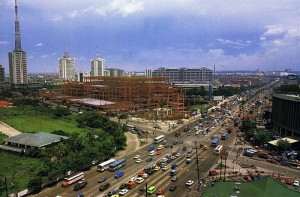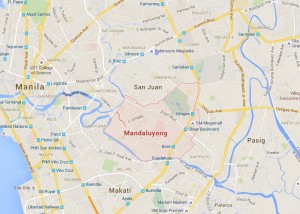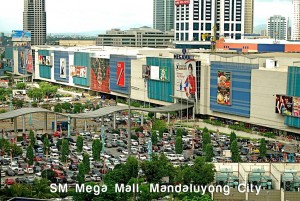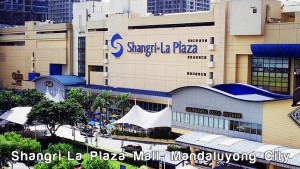Mandaluyong City is referred to as “Tiger City of the Philippines”, “Metro Manila’s Heart”, and the “Shopping Mall Capital of the Philippines”. It is well developed that many of its infrastructures are owned and managed by the most successful business men in the country.
History
 There are lots of sources of where this city got its name. Some claim that the place got its name from the Tagalog terms “mga” which means many and “daluy” which means flowing in the reference to the tall grasses that grow in the land many years ago. Another also claimed that it got its name from the incident when Acapulco, a navigator, saw that the rolling hills were frequently lashed at by “daluyong” or big waves from the sea. Hence the residents gave an answer to those who inquired about the name of the place as “madaluyong”. Later, the Spaniards affixed a consonant “n” to it thus making it Mandaluyong.
There are lots of sources of where this city got its name. Some claim that the place got its name from the Tagalog terms “mga” which means many and “daluy” which means flowing in the reference to the tall grasses that grow in the land many years ago. Another also claimed that it got its name from the incident when Acapulco, a navigator, saw that the rolling hills were frequently lashed at by “daluyong” or big waves from the sea. Hence the residents gave an answer to those who inquired about the name of the place as “madaluyong”. Later, the Spaniards affixed a consonant “n” to it thus making it Mandaluyong.
But prior to the Spanish conquest, Mandaluyong was already an organized place. It was part of what was once the Kingdom of Sapa of the Great Madjapahit Empire or “Anka Widyaya” and was ruled by Prince Balagtas, around 1300. More than a century later, about 1470, it expanded and was called the Kingdom of Namayan with Lakan Takhan as its ruler. The kingdom was made up of what are now Pandacan, Malate, Quiapo, Sta. Mesa, San Miguel, Paco and Sta. Ana in Manila, and Mandaluyong, Makati, San Juan, Pasay, Taguig, Pateros, Parañaque and parts of Pasig and Quezon City up to Diliman.
Mandaluyong was first known as a barrio of Sta. Ana de Sapa which was part of the District of Paco, Province of Tondo. It was then named as by the Spaniards as San Felipe Neri in honor of the Patron Saint of Rome. Year 1841, it was separated from Sta. Ana de Sapa.
When the Americans came, San Felipe Neri was consolidated with the municipality of San Juan del Monte. For several months in 1904, San Felipe Neri became the capital of Rizal. After its separation from San Juan del Monte in year 1907, San Felipe Neri became an independent municipality. It was then renamed as Municipality of Mandaluyong by virtue of the House Bill No. 3836. It became a city year 1994.
Today, Mandaluyong is a bustling city with vibrant economic activities and among many other city accomplishments.
Population/ Language/ Area
 According to 2010 census, the city had a population of 328,699 living in the total land area of 1,124.97, considered as the 18th largest metropolitan city in the world. Much of the city’s land is being occupied by the residential areas of Wack-Wack, Addition Hills, Plainview and Highway Hills. The land characteristic is partially flat on the southwest portion with gentle slopes in the rest of the area.
According to 2010 census, the city had a population of 328,699 living in the total land area of 1,124.97, considered as the 18th largest metropolitan city in the world. Much of the city’s land is being occupied by the residential areas of Wack-Wack, Addition Hills, Plainview and Highway Hills. The land characteristic is partially flat on the southwest portion with gentle slopes in the rest of the area.
Even though the city has various ethnic origins, most of the people here speaks Tagalog. Some however speaks Bicol, Bisaya, Ilonggo, and Ilocano languages.
Products and Services
Mandaluyong City is now commercially developed with a lot of central businesses such as banks, offices and service establishments. Major commercial districts are Boni Avenue, Shaw Boulevard, Libertad-Sierra Madre, Kalentong, San Franciso, part of Martinez, Sgt. Bumatay towards Barangka Drive and Pinatubo towards EDSA. In the eastern portion of the city it also has the famous malls and establishments such as the Megamall, Shangri-La, Podium and San Miguel Corporation. Almost all businesses and personal services stores dominates the whole roads in the city.
Business Opportunity
The city is rich for opportunities for business and investments. Banks, hotels, commercial centers almost make up the city.
Tourist Spots
Some of the attractions in the city are the Ortigas Center, one of the centers of business and commerce in the metropolis. Part of the Ortigas Center are the main headquarters of Asian development bank, Banco De Oro, and the headquarters of San Miguel Corporation, Southeast Asia’s largest food and beverage company. Also located here is the Unilab, one of the most prominent pharmaceutical laboratories and factories.
Some of the hotels and business parks of the city are;
- SM Megamall – is a large shopping mall located in the Ortigas Bisiness Centers of Metro Manila. It is one of the largest SM Supermall developed and operated by SM Prime Holdings, the largest mall operator in the Philippines owned by Henry Sy Sr. The mall has two buildings interconnected with a bridge. The mall occupies a land area of approximately 21 hectares and has a total floor area of an estimated 480,000 m², making it the largest shopping mall in the country as it redeemed its title from the previous holder SM North EDSA. The mall has a maximum capacity of 4 million people. It is as large as the Changi Airport Terminal 2 in Singapore.

- Shangri-La Plaza Mall- is an upscale shopping mall situated in the Ortigas Center, a business/commercial district of Mandaluyong City. It is surrounded by four streets in the commercial area, namely, Internal Avenue, St. Francis Avenue, Shaw Boulevard and the major highway EDSA. Affectionately called “The Shang”, this seven-story structure is also accessible through the Shaw Boulevard MRT Station in the fifth floor which connects it to the Manila Metro Rail Transit System. It is also the only retail arm of Kuok Group of Companies, the owner of the worldwide chain of Shangri-La Hotels and Resorts. The mall has several international stores such as Gucci, Calvin Klein, Burberry, Dolce and Gabbana, Hugo Boss and Polo Ralph Lauren.

- Forum Robinsons- is a specialty mall within Cybergate, a modern business and residential complex at the corner of EDSA and Pioneer Street in Mandaluyong. The shopping center highlights information technology product categories such as computers, cellphones and other mobile/wireless gadgets, digital cameras, and audio-video and computer gaming equipment. Complementing this mix are four anchor stores, four cinemas and a wide array of satisfying shopping, dining, amusement and service outlets.
- St. Francis Square Mall- is one of the notable shopping center in the city, the mall is a modern low-rise building holding a 3,000 capacity auditorium and houses over 1,000 stalls and stores.
Aside from the malls and shopping centers, Mandaluyong also has tourist spots that reflects the history. To name a few:
- Dambana ng mga Alaala (Memorial Monument) – a monument for the people who struggled for liberty and freedom during the revolution period.
- Don Bosco Technical College – used to be known as San Carlos Seminary. The Japanese made this as their headquarters during the World War II.
